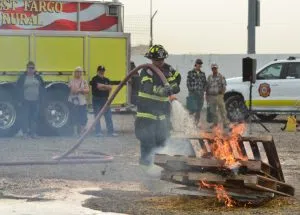
A firefighter sprays a mixture of water and foam during a demonstration of a soy-based firefighting foam on Sept. 10, 2024, in West Fargo. (Jeff Beach/North Dakota Monitor)
(North Dakota Monitor) -In the search for a more eco-friendly firefighting foam, soybeans may be the answer to moving away from “forever chemicals.”
Forever chemicals has become the common term for perfluoroalkyl and polyfluoroalkyl substances, also known as PFAS.
The Environmental Protection Agency calls them widely used, long-lasting chemicals that break down very slowly over time. They also have been a common ingredient in foam used to fight fires and have been linked to high rates of cancer among firefighters.
“While PFAS contamination is bad and something that we’re sorting through, it’s very effective as a firefighting foam. And folks whose lives have been saved by it likely appreciate that,” Adam Driscoll of Minneapolis-based Barr Engineering told a North Dakota conference of the Air and Waste Management Association in Bismarck last week. “That’s the difficult decision that folks are wrestling with at the moment.”
But one alternative may be a foam based out of soybeans that is completely biodegradable.

Cross Plains Solutions demonstrated its firefighting foam at the Big Iron Farm and Construction Show in West Fargo this week.
The company launched its product in April with the help of investment from the United Soybean Board, and state groups, including North Dakota.
The groups are funded through a “checkoff,” a fraction of the price of each bushel of soybeans sold that is used to pay for things such as research and development of new products, such as the firefighting foam.
“What better way to use checkoff dollars and funding something that, not only our farmers receive benefit from, but also those that are out there fighting fires,” said Cindy Pulskamp of Hillsboro, a member of the United Soybean Board.
John Hejl is both a soybean farmer and a firefighter. He farms near Casselton, west of Fargo, and is the chief of the Casselton Volunteer Fire Department, which serves a large rural area.
He said he had been looking for an alternative to PFAS foams and has been impressed with the Cross Plains Solutions product.
He said the foam reduces the amount of water firefighters need to put out a fire.
During the demonstration, firefighters set fire to diesel fuel contained within a barrel that had been cut in half.
Foam was sprayed around the fire to prevent it from spreading and then used to douse the fire. The foam’s ability to create a barrier could have applications in prescribed burns, such as forests.
Hejl said if it was a railcar full of diesel on fire, it would take hundreds of thousands of gallons of water to put it out without using foam.
“So by the time you put it out, it’s flowed into every ditch and stream and waterway for miles. If we can cover it with a blanket of foam and keep it in the ditch, then we’ve protected the lake and the river and the stream,” Hejl said.
Karolin Jappe is the emergency manager for McKenzie County, in the heart of North Dakota’s Bakken oilfield.
She said when volunteer firefighters respond to a fire at an oil facility, the company will sometimes ask if there is PFAS in the firefighting foam.
The reason for the question is that, when the smoke clears, cleaning up the PFAS requires taking it to a special landfill, making the cleanup more expensive.
“There is no prohibition against it,” Driscoll said of the PFAS foams. “But then, once it’s used, it has to be dealt with.”
There are no prohibitions against disposing of PFAS in landfills in North Dakota, but landfills can reject any load, according to Ivana Striebel in the Department of Environmental Quality’s Hazardous Waste Program.
If no municipal landfill in North Dakota would accept the contaminated soil, then the load could go to one of the state’s two industrial landfills. If the soil was rejected there, then the soil would have to be shipped out of state and most likely be disposed of as hazardous.
Streibel said North Dakota has no hazardous materials dump sites.
But with the biodegradable foam, there is no hazardous materials risk, unless whatever was burning was a hazardous substance.
Alan Snipes, CEO of Cross Plains Solutions, said the company’s product, SoyFoam, is the only biodegradable firefighting foam on the market and sits about mid-range on price compared to other foams.
The product is manufactured in Georgia but Snipes said the company has identified other sites that can produce the foam if demand increases.
SoyFoam represents a potential new market for soybeans, which can be used for many non-food products, including tires and shoes.
Until recent months, most of the soybeans grown in North Dakota had been shipped to markets in Asia. The opening of two soybean crushing plants at Spritwood and Casselton means that North Dakota can process about half the soybeans it grows.
Crushing separates the beans into oil, meal and hulls. The oil can be used in the food industry and heavy industry, for products such as renewable diesel.
Soybean meal is largely used for livestock feed but can also be processed into flour that is the basis for the foam.
“We have more meal than we know what to do with,” Hejl said.

Dave Garlie is the primary developer of the Cross Plains Solutions SoyFoam product. Garlie, who did his graduate research in chemistry at North Dakota State University, lives in Wisconsin but the company is based in Georgia.
He said one of the biggest challenges for the company is that different states and government agencies have different standards for firefighting foam. That means performing many different tests to prove that the product meets those standards.
He said federal agencies such as the Department of Defense and the U.S. Forest Service have a huge need for biodegradable firefighting foam but each have a different certification process.
He said the public has become more aware of the dangers of PFAS in firefighting and the company wants to demonstrate how safe its product is.
“What we’re trying to do is rebuild community confidence,” Garlie said. “That’s why we’re here at these farm technology shows.”









